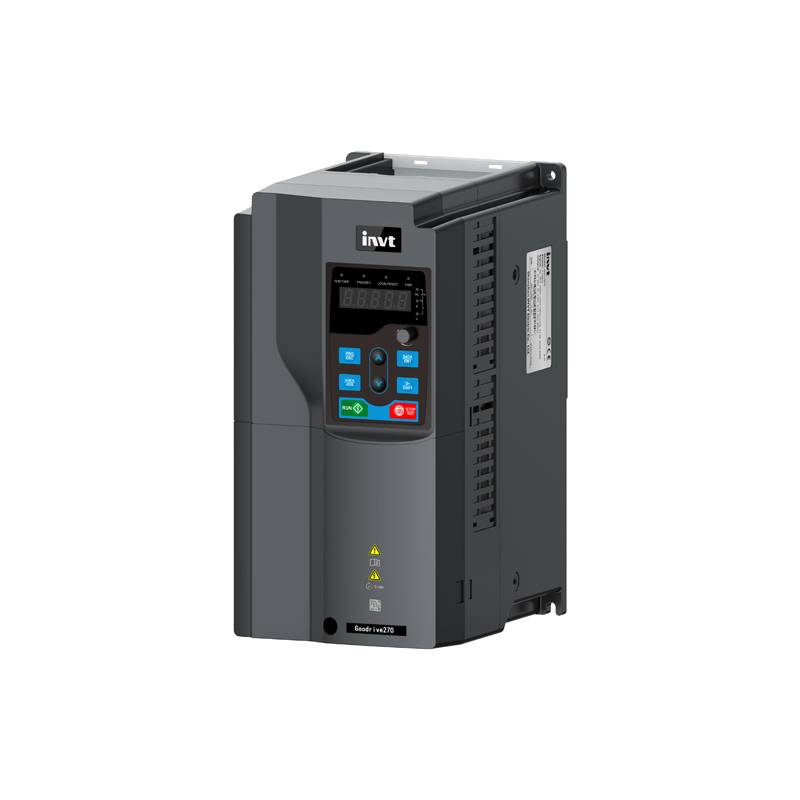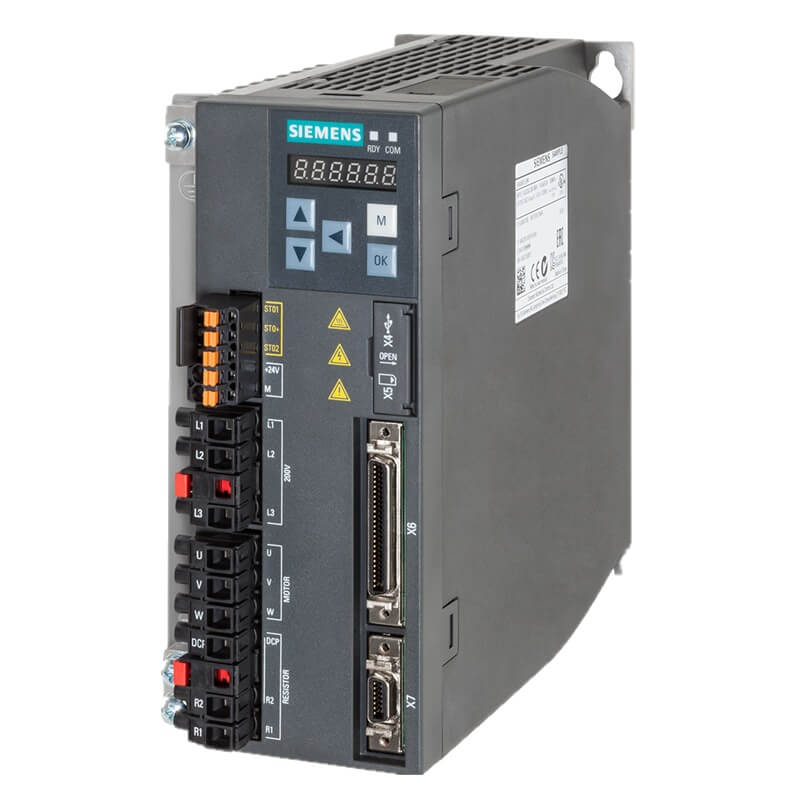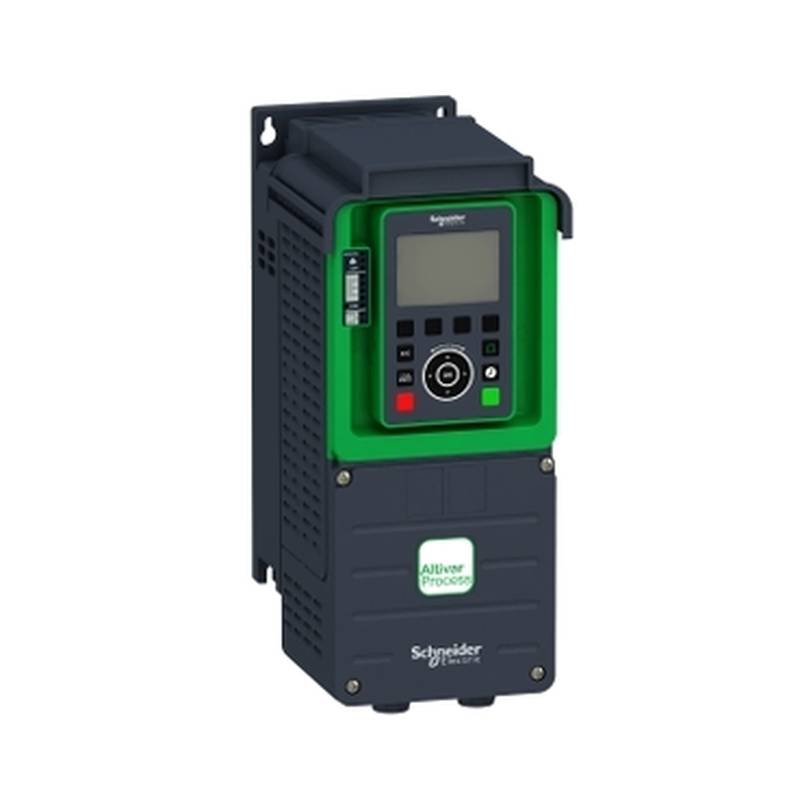
The INVT GD270-200-4 High Power VFD for Fan Drive is engineered for demanding industrial applications, delivering exceptional performance, energy efficiency, and robust control for large fan systems. Its core advantages lie in its advanced control algorithms, superior power handling capabilities, and comprehensive protection features, making it a premier choice for optimizing HVAC, ventilation, and process air applications. Key technical specifications include a rated power of 200kW, an input voltage range of 3-phase 380V-440V (or 400V/440V ±10%), and an output frequency range of 0-300Hz. The GD270 series boasts a high starting torque capability and precise speed regulation, ensuring stable and efficient operation even under fluctuating load conditions.
Core Features & Market Positioning
The INVT GD270-200-4 distinguishes itself through its advanced sensorless vector control technology, offering precise speed and torque control without the need for external motor encoders. This simplifies installation and reduces potential points of failure, a significant advantage in industrial environments. Its robust design incorporates advanced thermal management and comprehensive protection functions, including overcurrent, overvoltage, undervoltage, overheat, and phase loss protection, safeguarding both the VFD and the connected motor. The unit's modular design also facilitates maintenance and potential future upgrades, positioning it as a cost-effective and reliable long-term solution in the high-power VFD market. Its market positioning emphasizes reliability, energy savings, and ease of integration for large-scale fan applications.
Key Application Scenarios
This high-power Variable Frequency Drive (VFD) is ideally suited for a wide array of industrial fan applications where precise control and significant energy savings are paramount. It excels in large-scale HVAC systems within commercial buildings, industrial plants, and data centers, where maintaining optimal airflow and temperature while minimizing energy consumption is critical. The INVT GD270-200-4 is also a robust solution for industrial ventilation systems in mining operations, tunnels, and manufacturing facilities, ensuring efficient air exchange and pollutant removal. Furthermore, its capabilities extend to process air applications, such as in power plants for induced draft (ID) and forced draft (FD) fans, and in high-volume exhaust systems, where consistent and adjustable airflow is essential for operational efficiency and safety.
Practical System Integration Guidance
Integrating the INVT GD270-200-4 into existing fan drive systems requires careful attention to wiring and parameter configuration. For power connections, ensure the input power supply is correctly phased and within the specified voltage tolerance (380V-440V ±10%). Motor wiring should utilize appropriate shielded cables to minimize electromagnetic interference (EMI), with proper grounding of both the VFD and the motor chassis. When programming, initial setup should focus on motor parameter auto-tuning to optimize performance and protection. Key parameters to configure include the rated motor current, rated motor voltage, base frequency, and maximum/minimum frequency limits. For fan applications, setting up the V/f curve or sensorless vector control is crucial for achieving desired airflow control and energy savings. Enabling specific fan-related functions, such as fire mode or energy-saving modes, can further enhance operational efficiency.
Operation and Risk Mitigation
Safe and efficient operation of the INVT GD270-200-4 High Power VFD for Fan Drive hinges on understanding its operational parameters and potential fault conditions. During normal operation, monitor motor speed, current draw, and VFD temperature to ensure they remain within acceptable limits. Regular inspection of ventilation filters and heatsinks is essential to maintain optimal thermal performance. Risk mitigation involves adhering strictly to installation guidelines, particularly regarding proper grounding and wiring to prevent electrical hazards and EMI. Crucially, familiarize yourself with common fault codes. For instance, fault code E01 typically indicates an overcurrent condition, requiring an inspection of the motor load and acceleration ramps. Fault E02 often signifies an overvoltage fault, suggesting issues with regenerative braking or line voltage fluctuations. Promptly addressing these faults according to the user manual is vital to prevent equipment damage and ensure system reliability.
Scalability & Long-Term Value
The INVT GD270-200-4 offers significant long-term value through its inherent scalability and compatibility with evolving industrial automation trends. Its robust construction and advanced control capabilities ensure a long operational lifespan, minimizing the need for premature replacement. For facilities looking to enhance their industrial control systems, the GD270 series supports various communication protocols (e.g., Modbus RTU, Profibus DP via optional modules), facilitating seamless integration into SCADA systems and Distributed Control Systems (DCS). This enables centralized monitoring, control, and data acquisition, aligning with the principles of Industry 4.0 and the Industrial Internet of Things (IIoT). The drive's ability to precisely control fan speeds translates directly into substantial energy savings over its lifetime, providing a strong return on investment through reduced electricity consumption and maintenance costs.
Frequently Asked Questions (FAQs)
What are the primary benefits of using the INVT GD270-200-4 for fan drives?
The INVT GD270-200-4 offers significant energy savings by precisely controlling fan speed based on demand. It also extends motor lifespan by reducing mechanical stress during startup and operation. Its advanced control ensures stable airflow and improved system efficiency.
This VFD reduces wear and tear on fan components, leading to lower maintenance costs. It provides precise speed regulation, ensuring optimal performance in various environmental conditions. Its robust protection features safeguard against electrical faults.
The drive's ability to adjust output frequency allows for a finer degree of airflow control than fixed-speed systems. This leads to enhanced comfort in HVAC applications and better process control in industrial settings.
How does the sensorless vector control of the INVT GD270-200-4 benefit fan applications?
Sensorless vector control eliminates the need for an encoder on the motor, simplifying installation and reducing complexity. This reduces potential failure points in harsh industrial environments. It provides accurate torque control and fast dynamic response.
This control method allows the VFD to achieve precise speed regulation without feedback devices. It is highly effective for fan loads, offering excellent performance even at low speeds. This translates to more stable and efficient air delivery.
The absence of an encoder means lower initial cost and reduced maintenance requirements. It simplifies motor selection and replacement, as specialized encoder-equipped motors are not required for high-performance control.
What are common installation and wiring considerations for the INVT GD270-200-4?
Ensure the power supply is a stable 3-phase 380-440V source, within ±10% tolerance for reliable operation. Use appropriately sized, shielded cables for motor connections to minimize electromagnetic interference (EMI).
Proper grounding of both the VFD chassis and the motor is critical for safety and preventing electrical noise. Connect the control wiring for digital inputs, analog inputs, and communication ports according to the product manual's schematics.
Before applying power, double-check all connections for correctness and security. Perform motor auto-tuning after initial setup to optimize the VFD's performance parameters for the specific motor and fan load.
How can I configure the INVT GD270-200-4 for optimal fan performance?
Set the motor's rated power, voltage, and frequency accurately during the initial auto-tuning process. Adjust acceleration and deceleration times to avoid mechanical shock and ensure smooth speed transitions.
Configure the V/f curve or sensorless vector control parameters to match the fan's aerodynamic characteristics. Optimize the carrier frequency for a balance between motor noise reduction and thermal performance.
Utilize dedicated fan control functions like PID control for automatic speed adjustment based on pressure or temperature sensors. Set up appropriate protection limits for overcurrent, overvoltage, and motor overheating.
What troubleshooting steps should I take if the INVT GD270-200-4 displays a fault code?
Identify the specific fault code displayed on the VFD's keypad or interface. Consult the INVT GD270 user manual for a detailed explanation of the fault code and its probable causes.
Common faults include overcurrent (e.g., E01), overvoltage (e.g., E02), and motor overheating (e.g., E04). Address the underlying issue, such as checking for motor overloads, ensuring stable line voltage, or verifying fan impeller conditions.
After resolving the fault condition, reset the VFD by powering it off and then on again, or by using the reset function within the VFD's menu. If the fault persists, contact technical support for further assistance.
What communication protocols are supported by the INVT GD270-200-4 for system integration?
The standard communication protocol for the INVT GD270 series is Modbus RTU, allowing for integration with various automation systems. Optional communication interface cards can extend support to other industrial fieldbuses.
These optional cards often include support for protocols like Profibus DP, DeviceNet, and CANopen, enabling seamless connectivity with different PLCs and SCADA systems. This flexibility is key for modern industrial automation.
By supporting these protocols, the GD270-200-4 can be easily monitored, controlled, and integrated into larger IIoT and Industry 4.0 platforms for advanced data analytics and remote management.
How does the INVT GD270-200-4 contribute to energy efficiency in industrial fan systems?
The VFD adjusts fan speed according to actual system demand, rather than running at full speed constantly. This variable speed operation can lead to substantial energy savings, often exceeding 30-50% compared to fixed-speed drives.
By precisely matching fan output to requirements, it prevents energy wastage associated with over-ventilation or unnecessary airflow. This optimization is particularly impactful in HVAC and large-scale industrial ventilation where loads fluctuate.
The drive's efficient power electronics and advanced control algorithms minimize energy losses within the VFD itself, further enhancing overall system efficiency and reducing operational costs.
Can the INVT GD270-200-4 be used with different types of fan motors?
Yes, the INVT GD270-200-4 is designed to work with standard 3-phase AC induction motors commonly used in fan applications. Its auto-tuning feature calibrates the VFD to the specific motor parameters for optimal performance.
It supports a wide range of motor power ratings up to its maximum capacity of 200kW. Proper motor selection based on the fan's torque and speed requirements is crucial for efficient operation.
The VFD can be configured for different motor control modes, including V/f control and sensorless vector control, to ensure compatibility and high performance across various motor types and load characteristics.
What are the typical operating temperature and environmental considerations for this VFD?
The INVT GD270-200-4 typically operates within an ambient temperature range of -10°C to +40°C (50°F to 104°F), though derating may be required at higher temperatures. Ensure adequate ventilation around the drive.
It is designed for industrial environments and should be protected from excessive dust, moisture, and corrosive gases. Proper enclosure and mounting are essential to maintain its operational integrity and longevity.
Regular cleaning of heatsinks and ventilation openings helps prevent overheating, which is a common cause of VFD failure. Consider using environmental protection accessories if operating in challenging conditions.
How does the protection features of the INVT GD270-200-4 safeguard the fan motor?
The VFD includes comprehensive built-in protection against common electrical hazards such as overcurrent, overvoltage, and undervoltage. This prevents damage to the motor and the VFD itself during abnormal conditions.
It also provides motor-specific protections like phase loss detection and thermal overload protection, which monitors motor temperature to prevent overheating and winding damage. This ensures motor longevity.
By detecting and responding rapidly to fault conditions, the INVT GD270-200-4 minimizes downtime and costly repairs associated with motor failures, contributing to overall system reliability and operational continuity.

























